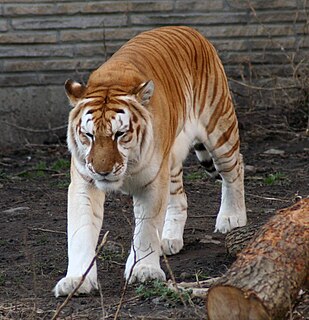
Maahes was an ancient Egyptian lion-headed god of war, whose name means "he who is true beside her". He was seen as the son of the Creator god Ptah, as well as the feline goddess whose nature he shared. Maahes was a deity associated with war, protection, and weather, as well as that of knives, lotuses, and devouring captives. His cult was centred in Taremu and Per-Bast, the cult centres of Sekhmet and Bast respectively.
Feline immunodeficiency virus (FIV) is a lentivirus that affects cats worldwide. From 2.5% up to 4.4% of cats worldwide are infected with FIV. FIV differs taxonomically from two other feline retroviruses, feline leukemia virus (FeLV) and feline foamy virus (FFV), and is more closely related to human immunodeficiency virus (HIV). Within FIV, five subtypes have been identified based on nucleotide sequence differences coding for the viral envelope (env) or polymerase (pol). FIV is the only non-primate lentivirus to cause an AIDS-like syndrome, but FIV is not typically fatal for cats, as they can live relatively healthily as carriers and transmitters of the disease for many years. A vaccine is available although its efficacy remains uncertain. Cats will test positive for FIV antibodies after vaccination.

The lion-tailed macaque, or the wanderoo, is an Old World monkey endemic to the Western Ghats of South India.

Gir National Park and Wildlife Sanctuary, also known as Sasan Gir, is a forest and wildlife sanctuary near Talala Gir in Gujarat, India. It is located 43 km (27 mi) north-east of Somnath, 65 km (40 mi) south-east of Junagadh and 60 km (37 mi) south-west of Amreli. It was established in 1965, with a total area of 1,412 km2 (545 sq mi), of which 258 km2 (100 sq mi) is fully protected as national park and 1,153 km2 (445 sq mi) as wildlife sanctuary. It is part of the Kathiawar-Gir dry deciduous forests ecoregion.

A golden tiger, golden tabby tiger or strawberry tiger is a tiger with a colour variation caused by a recessive gene. The colouration is a result of captive breeding and inbreeding. Like the white tiger, it is a colour form and not a separate species.

The Asiatic lion is a Panthera leo leo population in India. Its range is restricted to the Gir National Park and environs in the Indian state of Gujarat. On the IUCN Red List it is listed under its former scientific name Panthera leo persica as Endangered because of its small size and area of occupancy.

A werecat is an analogy to "werewolf" for a feline therianthropic creature.

Feline viral rhinotracheitis (FVR) is an upper respiratory or pulmonary infection of cats caused by Felid alphaherpesvirus 1, of the family Herpesviridae. It is also commonly referred to as feline influenza, feline coryza, and feline pneumonia but, as these terms describe other very distinct collections of respiratory symptoms, they are misnomers for the condition. Viral respiratory diseases in cats can be serious, especially in catteries and kennels. Causing one-half of the respiratory diseases in cats, FVR is the most important of these diseases and is found worldwide. The other important cause of feline respiratory disease is feline calicivirus.
The Feline Conservation Federation (FCF) is a 501(c)(3) non-profit organization based in the United States dedicated to the preservation, protection, and propagation of all species of wild felines. The members are a wide range of exotic cat enthusiasts such as professional breeders, educators, sanctuary and zoo owners, and individual "pet" owners, although ownership of an exotic feline is not required for membership.

Darrah National Park in Rajasthan, India is a national park established in 2004 consisting of three wildlife sanctuaries: Darrah Wildlife Sanctuary, Chambal Wildlife Sanctuary, and Jawahar Sagar Wildlife Sanctuary. It is located within the Kathiawar-Gir dry deciduous forests' ecoregion.

Kuno National Park is a protected area in Madhya Pradesh that received the status of national park in 2018. The protected area was established in 1981 as a wildlife sanctuary with an area of 344.686 km2 (133.084 sq mi) in the Sheopur and Morena districts. It was also known as Kuno-Palpur and Palpur-Kuno Wildlife Sanctuary. It is part of the Kathiawar-Gir dry deciduous forests ecoregion.

Puma is a genus in the family Felidae that contains the cougar, and may also include several poorly known Old World fossil representatives. In addition to these potential Old World fossils, a few New World fossil representatives are possible, such as Puma pumoides and the two proposed species of the so-called "American cheetah".

Tiefenthal is a municipality in the district of Bad Kreuznach in Rhineland-Palatinate, in western Germany.
Tweety's Circus is a "Merrie Melodies" cartoon animated short starring Tweety, Sylvester, and various circus animals. Released June 4, 1955, the cartoon is directed by Friz Freleng. All the voices are performed by Mel Blanc.
Puma lentivirus (PLV) is a retrovirus. A study in 2003 indicated that domestic cats infected with puma lentivirus (PLV) or lion lentivirus (LLV) began producing anti-FIV immune responses.

Lion is a color that is a representation of the average color of the fur of a lion.
The Torre Argentina Cat Sanctuary is a cat shelter in Rome, Italy, that makes use of the ancient ruins of Largo di Torre Argentina by providing a home within them for around 150 cats. After the excavation of the temple ruins in 1929, feral cats moved into the area, sheltered by roman pillars and fed by locals. In the 1950s, an actor named Antonio Crast, found the old warehouse where archeologists in the 20s kept there tools. It was there that he began feeding the feral cats.The keys to the warehouse were passed down until they landed in the hands of the founders of the sanctuary—one of them being Lia Dequel. Since then the shelter has grown, with volunteers coming every day of the week to feed, care for, and vaccinate the cats.














